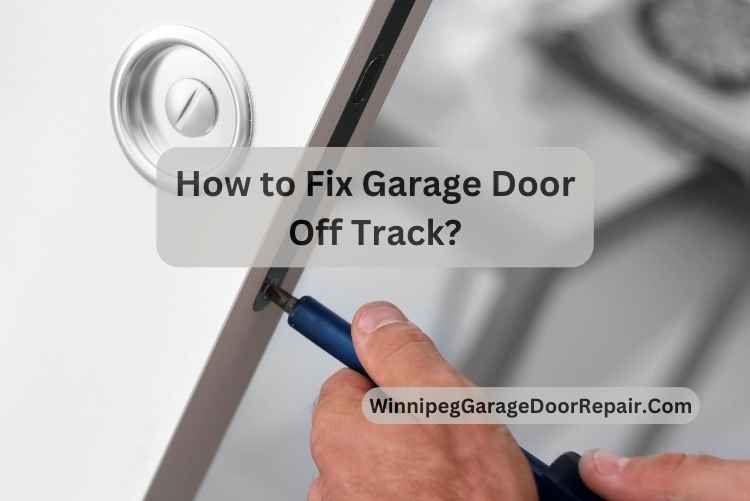Have you ever come home to find your garage door hanging awkwardly to one side, refusing to close or open properly? It’s a common issue but one that can cause a lot of inconveniences. Fortunately, with a bit of know-how and some elbow grease, you can get your garage door back on track and functioning smoothly. If you’re in the area, seeking professional garage door Winnipeg repair services can ensure your door is repaired efficiently and safely.
This article will guide you through the process, covering everything from the initial safety precautions to the final checks. Whether you decide to tackle the repair yourself or call in the experts, you’ll know what to expect. So, if you’re ready to tackle this problem head-on, let’s get started!
Steps to Get Your Garage Door Back on Track
A garage door off its track can be more than just a nuisance; it can also pose a security risk to your home. Follow these detailed steps to address the issue safely and efficiently.
Step 1: Disconnect the Opener
Safety First: Before attempting any repairs, especially when you need to repair a garage door with rotted wood at the bottom, ensure your safety by disconnecting the garage door opener. This is typically done by pulling a red cord hanging from the opener mechanism. This crucial step allows you to move the door manually, providing safer access to the damaged area without the risk of the opener engaging during the process.
Why It Matters: Disconnecting the opener is a vital safety measure that ensures the door remains stationary while you address the rotted wood at the bottom. This precaution prevents the door from accidentally activating during the repair, which could lead to injury or exacerbate the damage. Taking the time to secure the door in this way allows for a focused and safe repair process, highlighting the importance of safety in maintaining the longevity and functionality of your garage door.
Step 2: Open and Secure the Garage Door
Lifting the Door: With the opener disconnected, carefully lift the door to its fully open position. It’s important to have someone help you with this step to avoid strain or injury.
Securing the Door: Once fully open, secure the door in place using clamps or locking pliers on the tracks just below the bottom rollers. This prevents the door from crashing down unexpectedly.
Step 3: Bring Wheels Back to Track
Inspecting the Tracks: Before attempting to reseat the wheels, inspect the tracks for bends, damage, or obstructions that could have caused the door to derail. Remove any debris and use a mallet to gently straighten any bends.
Reseating the Wheels: With the tracks clear, carefully guide the wheels back onto the track. This may require loosening the brackets holding the tracks to allow a bit more flexibility. Once the wheels are aligned, retighten the brackets to secure the tracks.
Step 4: Manually Check for Proper Alignment
Testing Movement: After reseating the wheels, remove the clamps and manually move the door up and down a few times. This helps ensure that the door moves smoothly and that the wheels stay in the tracks.
Alignment Checks: Pay close attention to any points where the door seems to stick or wobble. These could indicate areas where the tracks need further adjustment or where the rollers may be damaged.
Step 5: Check the Automatic Operation
Reconnecting the Opener: Once you’re confident in the manual operation of the door and have checked or decided to replace the garage door lock to enhance security, reconnect the garage door opener by engaging the release mechanism you initially disengaged. This is an essential step to ensure both the mechanical and security aspects of the door are fully operational.
Testing Automatic Function: Operate the door using the opener to ensure it moves smoothly in automatic mode. Watch for any signs of hesitation or misalignment, which could indicate that further adjustments are needed. The replacement or maintenance of the garage door lock not only secures your garage but also ensures that the automatic operation is seamless, as all components are in their best condition.
Additional Tips and Considerations
Regular Maintenance: Prevent future issues by regularly inspecting and maintaining your garage door. This includes lubricating moving parts, checking for loose hardware, and ensuring the tracks are clean and free of debris.
When to Call a Professional: If at any point you feel uncomfortable with the repair process, or if the door or opener seems to have significant damage, it’s best to call a professional. Garage door systems are under a lot of tension and can be dangerous to work on without the proper knowledge and tools.
Safety Sensors: Don’t forget to check the garage door’s safety sensors after any repair. Misaligned or malfunctioning sensors can prevent the door from closing properly and pose a safety risk.
Conclusion
Fixing a garage door that’s come off its track can seem daunting, but with the right approach, it’s a manageable task. By following these steps, you can ensure your garage door operates smoothly and safely, protecting your home and providing convenient access. Remember, regular maintenance is key to preventing issues, but when problems arise, you now have the knowledge and confidence to address them. Always prioritize safety, and don’t hesitate to seek professional help for complex or dangerous repairs.







